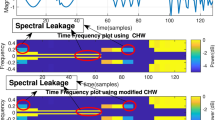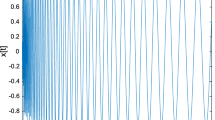Abstract
Complex harmonic wavelet (CHW) is a time–frequency tool that directly computes the frequency content rather than scales with respect to time. The complex harmonic wavelet for discrete signal computes N coefficients for N input samples, with the computational complexity of \(O(N\log _2 N)\) by employing the FFT algorithm. However, this wavelet function for discrete signal is not conjugate symmetric for positive and negative half-planes. Therefore, this paper proposes a new basis function termed modified complex harmonic wavelet transform by multiplying a phase term with CHW. The novelty of this phase multiplication leads the modified CHW to complex conjugate that reduces its computational complexity compared to existing CHW, attaining a computational gain up to \(25 \%\) asymptotically for larger sample points. Like CHW, this proposed modified CHW retains the properties of orthogonality and compact support in the frequency domain.













Similar content being viewed by others
Availability of data
Not applicable.
Code availability
Not applicable.
References
L. Arts, E. van den Broek et al., The fast continuous wavelet transformation (FCWT) for real-time, high-quality, noise-resistant time–frequency analysis. Nat. Comput. Sci. 1–12 (2022)
R. Brown, M. Lauzon, R. Frayne, A general description of linear time-frequency transforms and formulation of a fast, invertible transform that samples the continuous s-transform spectrum nonredundantly. IEEE Trans. Signal Process. 58(1), 281–290 (2010). https://doi.org/10.1109/TSP.2009.2028972
S.H. Cho, G. Jang, S.H. Kwon, Time-frequency analysis of power-quality disturbances via the Gabor–Wigner transform. IEEE Trans. Power Deliv. 25(1), 494–499 (2010)
C.K. Chui, Wavelets Mathematical Tool for Signal Analysis (SIAM, Philadelphia, 1997)
I. Daubechies, Where do wavelets come from? A personal point of view. Proc. IEEE 84(4), 510–513 (1996). https://doi.org/10.1109/5.488696
I.M. Dremin, O.V. Ivanov, V.A. Nechitailo, Wavelets and their uses. Phys. Usp. 44(5), 447 (2001)
D. Gabor, Theory of communication. Part 1: the analysis of information. Electrical engineers—Part III: radio and communication engineering. J. Inst. 93(26), 429–441 (1946). https://doi.org/10.1049/ji-3-2.1946.0074
K.Y. Guo, Q.Y. Qu, A.X. Feng, X.Q. Sheng, Miss distance estimation based on scattering center model using time-frequency analysis. IEEE Antennas Wirel. Propag. Lett. 15, 1012–1015 (2016)
D. Kaplun, A. Voznesenskiy, S. Romanov, E. Nepomuceno, D. Butusov, Optimal estimation of wavelet decomposition level for a matching pursuit algorithm. Entropy 21(9), 843 (2019)
Z. Leonowicz, T. Lobos, T. Sikorski, Time-frequency analysis of complex space phasor in power electronics. IEEE Trans. Instrum. Meas. 56(6), 2395–2403 (2007)
Z. Li, M.J. Crocker, A study of joint time-frequency analysis-based modal analysis. IEEE Trans. Instrum. Meas. 55(6), 2335–2342 (2006)
Y.H. Lin, M.S. Tsai, Development of an improved time-frequency analysis-based nonintrusive load monitor for load demand identification. IEEE Trans. Instrum. Meas. 63(6), 1470–1483 (2013)
W. Liu, S. Cao, Y. Chen, Seismic time-frequency analysis via empirical wavelet transform. IEEE Geosci. Remote Sens. Lett. 13(1), 28–32 (2016)
S. Mallat, W.L. Hwang, Singularity detection and processing with wavelets. IEEE Trans. Inf. Theory 38(2), 617–643 (1992)
D.E. Newland, Harmonic wavelet analysis. Proc. R. Soc. Lond. A 443(1917), 203–225 (1993)
D.E. Newland, Application of harmonic wavelets to time-frequency map**. In Fifth International Congress on Sound and Vibration, pp. 2043–2053 (1997)
T. Nguyen, Wavelets and Filter Banks (Wellesley-Cambridge Press, Wellesley, 1996)
R.S. Orr, The order of computation for finite discrete Gabor transforms. IEEE Trans. Signal Process. 41(1), 122 (1993)
G. Pagana, L. Galleani, S. Gross, M.R. Roch, E. Pastore, M. Poggio, G. Quaranta, Time-frequency analysis of the endocavitarian signal in paroxysmal atrial fibrillation. IEEE Trans. Biomed. Eng. 59(10), 2838–2844 (2012)
W.J. Staszewski, A.N. Robertson, Time-frequency and time-scale analyses for structural health monitoring. Philos. Trans. R. Soc. A Math. Phys. Eng. Sci. 365(1851), 449–477 (2007)
R. Stockwell, L. Mansinha, R. Lowe, Localization of the complex spectrum: the s transform. IEEE Trans. Signal Process. 44(4), 998–1001 (1996). https://doi.org/10.1109/78.492555
F. Tadel, S. Baillet, J.C. Mosher, D. Pantazis, R.M. Leahy, Brainstorm: a user-friendly application for MEG/EEG analysis. Comput. Intell. Neurosci. 2011, 8 (2011)
Y. Yang, Z. Peng, X. Dong, W. Zhang, G. Meng, Application of parameterized time-frequency analysis on multicomponent frequency modulated signals. IEEE Trans. Instrum. Meas. 63(12), 3169–3180 (2014)
H. Zhengyou, G. Shibin, C. **aoqin, Z. Jun, B. Zhiqian, Q. Qingquan, Study of a new method for power system transients classification based on wavelet entropy and neural network. Int. J. Electr. Power Energy Syst. 33(3), 402–410 (2011)
Acknowledgements
The authors would like to thank Deity, GOI, for partially using the utilities provided under SMDP-C2SD, Electrical Engineering Department (R &D/SP/EE/SMD/2015-16/126).
Funding
Not applicable.
Author information
Authors and Affiliations
Corresponding author
Ethics declarations
Conflict of interest
The authors declare that they have no conflict of interest.
Additional information
Publisher's Note
Springer Nature remains neutral with regard to jurisdictional claims in published maps and institutional affiliations.
Rights and permissions
About this article
Cite this article
Khatua, P., Ray, K.C. A Low Computational Complexity Modified Complex Harmonic Wavelet Transform. Circuits Syst Signal Process 41, 6462–6483 (2022). https://doi.org/10.1007/s00034-022-02095-3
Received:
Revised:
Accepted:
Published:
Issue Date:
DOI: https://doi.org/10.1007/s00034-022-02095-3




